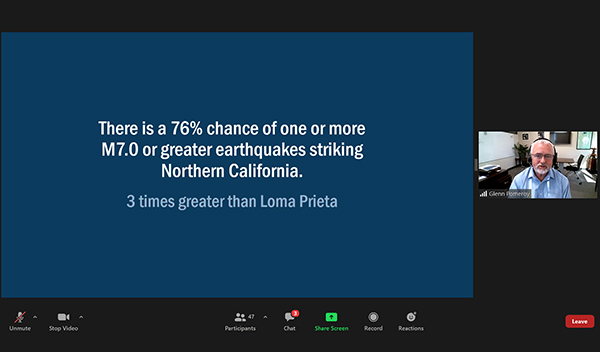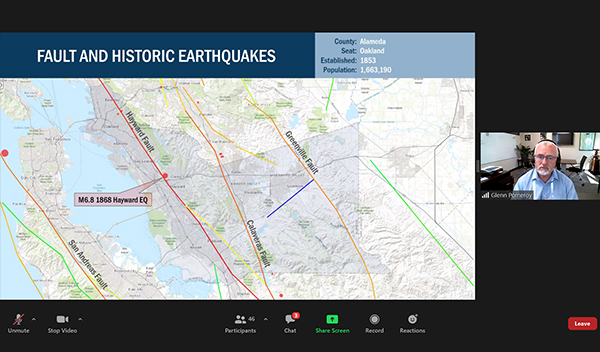In an ongoing effort to educate Californians on how to strengthen their homes against earthquake damage, CEA seized the opportunity to meet virtually with members of the Rotary Club of San Francisco—and reminded them that earthquakes don’t stop during a pandemic. We shared details about the risk of earthquakes striking the Bay Area, as well as the importance of protecting their homes and making them stronger to help reduce quake related loss.
In October, CEA CEO Glenn Pomeroy joined a Zoom webinar and shared with 47 members of the Rotary Club of San Francisco that most Californians live within 30 miles of an active fault. The Bay Area, for example, is home to a few well-known faults such as the San Andreas, Calaveras, and Hayward faults. According to scientists, there is a 76% chance of one or more M7.0 or greater earthquakes striking Northern California in the next 30 years. But even though earthquakes are inevitable, the damage they cause is preventable—so it is important for residents to act now.
In California, millions of homes, built before 1980, were constructed before modern seismic codes were put in place. These vulnerable houses require a residential seismic retrofit to help make them stronger. A retrofit in many instances can be quick, easy, and inexpensive. Once complete, a retrofit can help minimize shake damage to the home. Pomeroy provided examples of the damage some earthquakes caused to homes in the Bay Area, and ways to help prevent them.
The participating Rotarians expressed their familiarity with protecting their homes with residential earthquake insurance. Those who had purchased it said that it brought them peace of mind to know they would have the financial strength to help them recover from a damaging earthquake. Others were unsure if they should add such coverage to their existing home insurance policy. Pomeroy explained, that in California, acquiring a residential earthquake insurance policy is a choice.
CEA has tools for renters and homeowners to calculate their premiums and select the policy that better fits their needs. And our policyholders may be eligible to receive up to a 25% discount on their earthquake insurance premium if their older house has been strengthened or seismically retrofitted to withstand earthquakes.
As part of this earthquake education session, participants also learned what type of first aid items they should have on-hand and what they should do as soon as the earth starts shaking. CEA shared with them a list of items they should include in their earthquake safety kits, as well as the importance of knowing how to Drop, Cover, and Hold On when an earthquake strikes. Additional and valuable information, which we are sure will serve our community members to get prepared now to help reduce earthquake damage and worry less.




